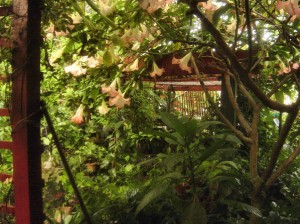 It is said that a garden, like a mirror, reflects more than it’s owner’s face. The experienced viewer sees more than a mere landscape thriving in dappled sunlight or tolerating a pounding rain. Among the living colors, winding tendrils and the fleshy, new growth coming from bulbs and tubers, there are dead things too. Those dead things are relics of unchangeable misfortune, miscalculation or simply a natural end of life. A good garden keeps what is dead and invites it’s newer members to use those deaths in marvelous and creative new ways.
It is said that a garden, like a mirror, reflects more than it’s owner’s face. The experienced viewer sees more than a mere landscape thriving in dappled sunlight or tolerating a pounding rain. Among the living colors, winding tendrils and the fleshy, new growth coming from bulbs and tubers, there are dead things too. Those dead things are relics of unchangeable misfortune, miscalculation or simply a natural end of life. A good garden keeps what is dead and invites it’s newer members to use those deaths in marvelous and creative new ways.
Misfortune forms a garden’s mystical archeology and defines it’s bones.
If you spend any amount of time among gardeners, you learn that they are as equally at home discussing utter failure and demise as they are new blooms and major triumph. A well adjusted gardener will chuckle with wistful regret when mentioning the $100.00 Jade Vine they killed outright with too much fertilizer, as easily as they will reservedly boast of the bloom that should never have been. These gardeners are a salty lot. They cherish odd things like stumps, dead trees with peeling, black bark and piles of discarded, brown rose petals. They hoard things broken and bruised, and see those things as essential for completing the artwork that represents their garden’s beating heart.
All of this is quite personal stuff. There’s an unseen connection between the gardener and the broken shovel currently entwined with passiflora. There’s a cosmic chord singing through the wind chimes made of old spoons and forks. The old stump, it’s nakedness exposed by wind and weather, reveals a texture as smooth as a lovingly sculpted Pieta. Discarded blossoms are missed opportunity and food for a riotous, newly sprouted bed of wild violets.
A wise gardener would never discount or overlook the value death has in their green world. Doing so would be like dismissing seen stars that are no more, or judging a patch of black sky lifeless and void. They know better. These gardeners know the end and the beginning and see them as very much the same. There’s an uncanny ability to envision a rusty, old Radio Flyer wagon as showroom new – while also determining to leave it as it is. After all, its been through so much. Let’s let it rest here among the four o’clocks and the old bicycle wheels in the stand of cleome.
Dead trees make for superb trellises. What better sight than a breathless, grandfather of a tree being annoyed by the careless romp of morning glories from branch to branch? They will reseed every year and annoy anew until every aged branch has tumbled to earth and inevitably joined it. Then, those abandoned vines will snake that ground until they find a tolerant fence or captive drain pipe. Dead things to be sure, but none so gloriously dead as that old tree.
Having once unearthed a shiny pocket watch in a garden when I was six, I know the archeological possibilities of a good garden dig. There have been brass buttons, spent shell casings, strange metal contraptions, coins, safety pins, the occasional earring, Lego men, very old tools, china pots, copper pipes the color of malachite, innumerable nails, springs, and the occasional odd bone unearthed within the scant 1/8th acre of our garden. All of these things, these found treasures were dropped by an unseen hand at an unknown time, under unknown circumstances. Each of them could be Kathy, lost on the Moors with Heathcliff crying out from beyond the fields of heather. Somebody lost this stuff. They owned it, wondered where it went after they couldn’t find it and eventually gave up on it. Now, they are like Kathy’s icy hand reaching out for you, reminding you that those who lost them are no more and you too shall be no more.
The wry romance and unchallengeable truth of dead things is that they give way to the roarings of rebirth. If you’ve ever planted a green bean seed, you have witnessed this very thing. A green bean is never happier than when its had a supper of nitrogen leeching from dead leaf compost. This scrumptious feast, when accompanied by a long draw of water laced with 20-20-20, causes a bean seed to race toward the sun like Seabiscuit out of the starting gate. The thing goes mad with sunlight and seeks romance with anything upright, or not. When the flowers come, every bee is unabashedly invited, every insect sent an engraved invitation. A bean flower is as wanton as a dancing girl and cares nothing of consequence. The result is tadpoles of offspring that fatten up as quickly and in profusion. The entire plant becomes a community of tadpoles coming forth and graduates going off to dinner plates. By the Fall there’s nary a bud, flower or pod. If there are one or two pods left, their beans are big and hard, almost inedible. The compost heap is a shriveling bean plant’s Riviera. It will sun until toasty, then hitch a ride on a herbaceous Viking ship to plant Valhala. If you torch the pile…so much the better.
That’s the thing about garden death. Its here, but its also there – wherever there might be. That’s the mirror, the element that reflects it’s owner face and is the seductive, collective definition of interaction, interdependence and inevitability.

